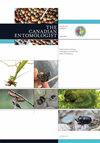Okanagan-Kootenay绝育昆虫项目中野生和差异量养冷蛾竞争力的野外测试比较
IF 1.1
4区 农林科学
Q3 ENTOMOLOGY
引用次数: 8
摘要
摘要采用春季野外放生试验,比较了育成不育、大量饲养、滞育和未滞育雄蛾(鳞翅目:扁桃科)与野生滞育雄蛾的信息素捕获量和交配活性。不育蛾由加拿大不列颠哥伦比亚省奥索尤斯的Okanagan-Kootenay不育昆虫释放(SIR)计划大规模饲养设施提供。非滞育饲养(sir标准)和滞育饲养(sir -滞育)不育雄鼠被捕获的频率相似。两种类型的不育雄虫被再次捕获的频率都明显低于同样释放的野生绝育雄虫,并且被再次捕获的不育雄虫与野生雄虫的比例与任何一种不育雄虫相似。使用标准雄性和绝育雄性的综合捕获量,用野生雌性诱捕器测得的不育雄性与野生雄性的比例(21:1)明显低于用10µg信息素诱捕器测得的比例(48:1)。两种捕获比例均显著低于野生雄性和不育雄性的80:1。在交配研究中,sir标准雄性和sir滞育雄性表现出相同的交配频率,并且两者在与拴住的野生雌性交配时都被捕获的频率明显低于释放的野生雄性。在相同的交配研究中,在释放前在太平洋农业食品研究中心(PARC)冷藏3小时的不育雄性(PARC-滞育)明显比平均24小时冷藏的SIR标准雄性或SIR滞育雄性更具竞争力。parc滞育的雄性和放生的野生雄性与拴着的雌性交配的频率相同。我们假设,SIR雄性在被释放前被冷藏的时间长度可能导致SIR雄性滞育的流动性较差,因此在野外交配试验中与野生雄性相比,与parc滞育的雄性相比竞争力较低。基于这些结果,目前不能推荐在Osoyoos设施使用的大规模饲养系统中引入滞育期作为提高诱捕器测量的不育雄性与野生雄性的比率或增加不育与野生交配的手段。本文章由计算机程序翻译,如有差异,请以英文原文为准。
Operational Mark—Release—Recapture Field Tests Comparing Competitiveness of Wild and Differentially Mass-Reared Codling Moths from the Okanagan—Kootenay Sterile Insect Program
Abstract
Pheromone trap catches and mating activity of sterile, mass-reared, diapaused and non-diapaused male codling moths, Cydia pomonella (L.) (Lepidoptera: Tortricidae), were compared with those of wild diapaused males using mark—release—recapture field experiments in springtime. Sterile moths were provided by the Okanagan—Kootenay Sterile Insect Release (SIR) Program mass-rearing facility, in Osoyoos, British Columbia, Canada. Nondiapause-reared (SIR-standard) and diapause-reared (SIR-diapaused) sterile males were recaptured in similar frequencies. Both types of sterile males were recaptured significantly less often than similarly released wild diapaused males, and ratios of recaptured sterile to wild males were similar with either sterile male. Ratios of sterile to wild males, using the combined catches of SIR-standard and SIR-diapaused males, were significantly lower when measured with traps baited with wild-females (21:1) than with traps baited with 10 µg pheromone (48:1). Both trapping ratios were markedly lower than the 80:1 ratio at which sterile and wild males were released. In mating studies, SIR-standard and SIR-diapaused males exhibited equivalent mating frequencies and both were recaptured in copula with tethered wild females significantly less often than released wild males. In the same mating studies, sterile mass-reared, diapaused males that had been chilled for 3 h at the Pacific Agri-Food Research Centre (PARC) before release (PARC-diapaused) were significantly more competitive than SIR-standard or SIR-diapaused males that averaged 24 h of chilling as part of normal SIR Program operations. PARC-diapaused males and released wild males mated with tethered females with equal frequency. We hypothesize that the length of time SIR males were chilled before being released may have caused SIR-diapaused males to be less mobile, and therefore less competitive with wild males in field mating assays, than were PARC-diapaused males. Based on these results, introduction of a diapause phase into the mass-rearing system used at the Osoyoos facility cannot currently be recommended as a means of improving trap-measured ratios of sterile to wild males, or increasing sterile × wild matings.
求助全文
通过发布文献求助,成功后即可免费获取论文全文。
去求助
来源期刊

Canadian Entomologist
生物-昆虫学
CiteScore
2.20
自引率
11.10%
发文量
24
审稿时长
6-12 weeks
期刊介绍:
French translation follows/le français suit Published since 1868, this peer-reviewed bimonthly publication is the official journal of the Entomological Society of Canada. Available via the internet and with hardcopy distribution to 55 countries, its research papers and notes are relevant to entomologists and other biologists around the world. In addition to being a venue for topical reviews and forum discussion, The Canadian Entomologist publishes current research in all facets of entomology, including systematics and morphology, molecular and developmental biology, ecology and behaviour, biodiversity and evolution, insect management, entomological techniques, and other relevant subject areas. Contributions are published in English or French. Authors will not pay page charges, and will experience fast, high quality reviews of their papers.Publiée depuis 1868, cette publication bimestrielle avec comité de lecture est la revue officielle de la Société d’entomologie du Canada. Disponible sur Internet et distribuée en format papier dans 55 pays, ses articles de recherche et ses notes sont pertinents pour les entomologistes et autres biologistes de par le monde. En plus d’être une plate-forme pour des revues thématiques et un forum de discussion, The Canadian Entomologist publie la recherche actuelle sur toutes les facettes de l’entomologie, incluant la systématique et la morphologie, la biologie moléculaire et développementale, l’écologie et le comportement, la biodiversité et l’évolution, la gestion des insectes, les techniques entomologiques et d’autres domaines pertinents. Les contributions sont publiées en français ou en anglais. Les auteurs ne paient aucun frais de publication, et recevront une révision rapide et de grande qualité de leurs articles.
 求助内容:
求助内容: 应助结果提醒方式:
应助结果提醒方式:


